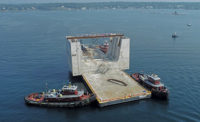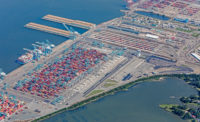CSX Virginia Avenue Tunnel Reconstruction
Washington, D.C.
Best Project, Airport/Transit
Owner: CSX Transportation
Design-Build Team: Clark/Parsons, a Joint Venture
Subcontractors: Clark Civil (Concrete); Clark Foundations (Support of Excavation); Clark Concrete; Metro Earthworks (Surface Demolition & Excavating); C3M Power Systems (Electrical & Tunnel Security Systems); Delta Railroad (Trackwork); Metro Paving (Roadway)
As planners at freight-rail giant CSX Transportation looked ahead to the Virginia Avenue Tunnel reconstruction project, they knew they needed to find ways to manage and mitigate the substantial risks of constructing a tunnel through busy sections of Washington, D.C., without affecting freight flow in a key rail corridor.
In naming the reconstruction ENR MidAtlantic’s Project of the Year, judges highlighted the team’s success in addressing logistical challenges, including coordinating with multiple government agencies and the local community—and maintaining freight rail traffic with no disruptions during 42 months of construction.
“It seems like it was a logistics nightmare, and I was very impressed that they were able to accomplish what they were able to accomplish with as many parties involved,” said one judge.
A critical part of the CSX plan, project managers agree, was the decision to use progressive design-build project delivery, which allowed the company to bring in contractor Clark Construction early in the process to help with constructibility and permitting. A joint venture of Clark and design firm Parsons is the design-builder.
Brandon Knapp, CSX project manager, says a major potential hurdle for the project was the National Environmental Policy Act (NEPA) process. “There were a lot of details that NEPA required from us early on, so we wanted to make sure we had the contractor’s input and also the contractor’s buy-in,” he says.
The permitting process was particularly contentious because the project spans 11 city blocks on Virginia Avenue SE from 2nd Street to 11th Street, potentially affecting parks, businesses, government offices and community centers. “We knew that getting the constructibility and the limits of disturbance correct were very important to us,” Knapp says.
Within two weeks of the project award in 2011, Clark/Parsons worked with CSX and NEPA consultants to develop a final design plan, including two alternatives. In all, Clark/Parsons worked with CSX to process more than 300 required permits, in addition to securing land-use acquisitions and rights agreements with owners of adjacent properties.
The original tunnel was built in 1872 and couldn’t accommodate demand for increased freight rail traffic along the I-95 corridor. The team’s approved plan called for replacing the 147-year-old single tunnel with two new tunnels that each can accommodate double-stack intermodal trains.
Construction started in May 2015, six months after the NEPA Record of Decision was reached. The project team developed critical early-start design packages for erosion and sediment control, stormwater management, utility relocations, maintenance of traffic, instrumentation and monitoring, initial support of excavation and selective demolition.
During the first phase of construction, the team relocated major utilities and demolished a portion of the existing tunnel’s south wall and roof to accommodate the new south tunnel alignment. While utility relocation was underway, the design-build team was able to continue finalizing other design packages.
A secant pile wall system was constructed beside the remaining portion of the south wall, which served to support excavation and become part of the permanent structure for the center dividing wall between the new tunnels.
Roula Sader, principal project manager for Parsons, says the secant wall system was selected to make sure the design optimized construction and reduced costs. “It was the most effective and efficient option,” she says.
Crews then constructed a new 4,100-ft, cut-and-cover, cast-in-place concrete tunnel structure adjacent to the active existing brick and stone masonry tunnel. The team used traveler form systems to construct 48-ft-long segments of both tunnel walls simultaneously, improving efficiency.
Once the first tunnel was completed and freight service was shifted to the new rail line, crews were able to finish demolition of the existing tunnel and construct a new tunnel in its alignment.
Philip Sheridan, Clark Construction senior vice president, says that constructing the tunnels without disrupting scheduled freight service on the corridor was one of the greatest technical challenges of the project. “To do what we did and build next to an unreinforced masonry tunnel and never disrupt one minute of traffic in 42 months was phenomenal,” he says. “Despite all of that proximity to active rail, we saw no incidents of any kind relative to freight rail or construction.”
Although the team was given a “general sense” of daily freight traffic, Sheridan says that schedules were constantly in flux, as any delay on one part of the corridor could affect the entire corridor. “We had direct radio communication at all times with the railroad employee in charge, so we had knowledge of all freight movements in the corridor,” he says. “Through that very detailed coordination with the railroad and our crafts, we were able to safely navigate tens of thousands of crossings on the railroad around freight traffic without incident.”
Several judges were particularly impressed with the design-builder’s ability to work around freight traffic. “CSX … those guys usually tell you ‘The train is coming in 30 minutes—get all your stuff off the track, we’re coming through,’ ” says one judge. “The railroad stops for nothing.”
Sheridan notes that part of the success of the project was the ability of the design-builder to work with a limited group of well-informed decision-makers from CSX. Knapp was one of four CSX employees involved in most owner decisions on the project. Every week during construction, the leadership team of the design-builder and the client walked the nearly one-mile-long job from end to end. “We’d spend two-and-a-half hours on Tuesday afternoons every week,” Sheridan says. “We’d walk up and down the tunnel regularly to the point that [Knapp] knew the crane operators by name.”
Sheridan says that level of understanding about the project enabled the team to make quick decisions. “At times, it was an old-school approach, where we’d make audibles in the field and then we’d execute,” he says. “The letter-writing between us resulted in a very short stack of paper.”
Another key CSX requirement was that the design-builder self-perform most of the work on the project. Clark was able to self-perform more than 70% of the work by leveraging several of its subsidiaries and affiliates, including Clark Civil, Clark Foundations, Clark Concrete, Metro Earthworks and C3M Power Systems.
CSX recognized that by requiring more self-performed work, the contractor had greater control of the overall schedule and could be nimbler with decision-making. Besides reducing risk, Knapp says it also gave the contractor the incentive to perform. “The idea was that the contractor had skin in the game and they weren’t just managing subcontractors,” he adds.
Clark/Parsons also faced the possibility of penalties and rewards throughout the project. That included the risk of liquidated damages if it missed three critical milestones: completion of the first tunnel, completion of the second tunnel and full restoration of affected sections of Virginia Avenue. Clark/Parsons met all three milestones ahead of schedule.
Additionally, CSX included incentives for Clark/Parsons to meet quarterly goals. “We had a portion of our fee tied to a scorecard at the quarterly review,” Sheridan says. “It weighed safety, schedule and other communications, such as how responsive were we to community concerns.” He adds, “We earned 92% of the maximum bonus money associated with the quarterly evaluation. For the complexity of the job, that’s pretty remarkable.”
With limited exceptions, CSX also placed most quality assurance/quality control responsibilities on the design-build team. CSX retained some critical track-quality testing responsibilities. “We did put a lot of responsibility on the Clark-Parsons team for the QA/QC process,” Knapp says. “We’ve done it in different ways on past projects, but this process worked well on this project.”
For the project’s final phase, the team reconstructed Virginia Avenue Southeast. The design incorporated many D.C. Dept. of Transportation (DDOT) historic features, including granite curbs, brick gutters, Washington Globe tear-drop lighting and a reconstructed park area. New project features include a bike path that connects the Capitol Hill neighborhood with the Anacostia River trail; a new dog park within the Virginia Avenue Park; and porous asphalt parking lanes along the roadway. In total, crews delivered 19,500 sq yd of pavement, 6,000 sq yd of sidewalk and four acres of landscaping.
More than 10,000 paving stones were recovered from the tunnel excavation and transferred to DDOT for reuse on other DDOT historic street repairs. Interpretive signs describe the history of the tunnel and related historical topics.
The tunnel is the last of 61 projects in CSX Transportation’s National Gateway Initiative, a multi-year infrastructure plan designed to improve rail connections and allow passage of double-stacked intermodal freight trains.
Knapp says CSX recognized that the tunnel would be the most daunting portion of the gateway program. “We typically don’t do these major types of projects, and we don’t do them in an urban setting like this,” Knapp says. “When we do large infrastructure projects, we tend to do them in a greenfield area.”
Despite tremendous logistical challenges, the team was able to complete construction of the guaranteed maximum price project on schedule and under budget—with a “shared savings” of more than $10 million, according to Sheridan—in December 2018. (CSX said the project cost was confidential.) But Sheridan says the success of the project stems from the decision by CSX to use progressive design-build.
“It built from Day 1 a collaborative framework of trust among the parties that was bar none,” Sheridan says.
“It was one of the most rewarding jobs I’ve done in my 37 years in the business,” he adds. “It really came down to CSX putting their complete trust in the design-build partner. This job was built on relationships.”
Back to "MidAtlantic's 2019 Best Projects Shine Across The Region"








